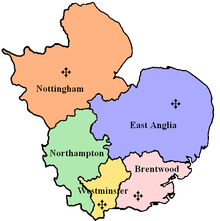Roman Catholic Diocese of East Anglia
Coordinates: 52°24′11″N 0°54′11″E / 52.403°N 0.903°E
| Diocese of East Anglia Dioecesis Angliae Orientalis | |
|---|---|
 | |
| Location | |
| Country | England |
| Territory | Counties of Norfolk, Suffolk, Cambridgeshire |
| Ecclesiastical province | Westminster |
| Metropolitan | Westminster |
| Deaneries | Bury St Edmunds, Cambridge, Coastal, Ipswich, King's Lynn, Norwich, North Norfolk, Peterborough |
| Statistics | |
| Area | 12,570 km2 (4,850 sq mi) |
| Population - Total - Catholics |
(as of 2011) 2,873,000 99,800[1] (3.5%) |
| Information | |
| Denomination | Roman Catholic |
| Rite | Latin Rite |
| Established | 13 March 1976 |
| Cathedral | St John the Baptist Cathedral, Norwich |
| Secular priests | 96 |
| Current leadership | |
| Pope | Francis |
| Bishop | Alan Hopes |
| Metropolitan Archbishop | Vincent Nichols |
| Vicar General | Anthony Rogers |
| Map | |
 Diocese of East Anglia within the Province of Westminster | |
| Website | |
| www.eastangliadiocese.org.uk | |
The Diocese of East Anglia is a diocese of the Latin Rite of the Roman Catholic Church covering the counties of Cambridgeshire, Norfolk, Suffolk and Peterborough in eastern England. The diocese makes up part of the Catholic Association Pilgrimage.
Statistics
There are 85,309 members of the church who belong to the 59 parishes in the diocese. The patrons of the diocese are Our Lady of Walsingham (24 September), St Felix (8 March) and St Edmund (20 November).
Boundaries
The diocese is divided into eight deaneries, which are in turn divided into 59 parishes.
- Bury St Edmunds: Brandon; Bury St Edmunds; Clare; Diss; Hadleigh; Haverhill; Newmarket; Stowmarket; Sudbury; Thetford.
- Cambridge: Buckden; Our Lady and the English Martyrs, Cambridge & Our Lady of Lourdes, Sawston; St Laurence, Cambridge; St Philip Howard, Cambridge; St Etheldreda's Ely; Huntingdon; St Ives; St Neots.
- Coastal: Beccles; Bungay; Gorleston; Lowestoft; Poringland; Southwold; Great Yarmouth.
- Ipswich: Aldeburgh; Felixstowe; St James, Ipswich; St Mark, Ipswich; St Mary, Ipswich; St Mary Magdalen, Ipswich; St Pancras, Ipswich; Woodbridge.
- King's Lynn: Dereham, Downham Market, Hunstanton, King's Lynn, Swaffham; Wisbech.
- Norwich: Costessey; St John's Cathedral, Norwich; St George's, Norwich; Wymondham.
- North Norfolk: Cromer; Fakenham; North Walsham; Sheringham; Walsingham.
- Peterborough: March; St Peter & All Souls, Peterborough; Our Lady of Lourdes & St Oswald, Peterborough; St Luke, Peterborough; Sacred Heart, Bretton; St Anthony's, Peterborough (Italian Mission); Polish Mission, Peterborough; Whittlesey.
History
On 13 March 1976, by the decree Quod Ecumenicum, Pope Paul VI formed the Diocese of East Anglia (from the counties of Cambridge, Norfolk and Suffolk) out of the Diocese of Northampton.
On 2 June 1976, the new diocese received its first bishop, Alan Clark. Bishop Clark had previously been auxiliary bishop of Northampton and co-chairman of ARCIC (Anglican/Roman Catholic International Commission), with the cathedral being established at the former parish church of St John the Baptist, Norwich. As the first bishop of the new diocese, Bishop Clark had to set up all the necessary instruments and commissions for the diocese to operate successfully. The establishment of the Diocesan Pastoral Council in 1987 strengthened these.
The diocese continued to grow with the development of the diocesan offices and diocesan tribunal attached to Bishop's House in Poringland near Norwich. Bishop Clark led a number of Lourdes pilgrimages.
Ordinaries
- Alan Charles Clark (appointed on 26 April 1976 – retired on 21 March 1995)
- Peter David Smith (appointed on 21 March 1995 – translated to the Archdiocese of Cardiff on 26 October 2001)
- Michael Charles Evans (appointed on 14 February 2003 – died in office on 11 July 2011)
- Alan Hopes (appointed on 11 June 2013)
Pilgrimage
The diocese makes up part of the Catholic Association Pilgrimage.
References
- ↑ "Catholic Hierarchy: Diocese of East Anglia". Retrieved 2008-11-28.
